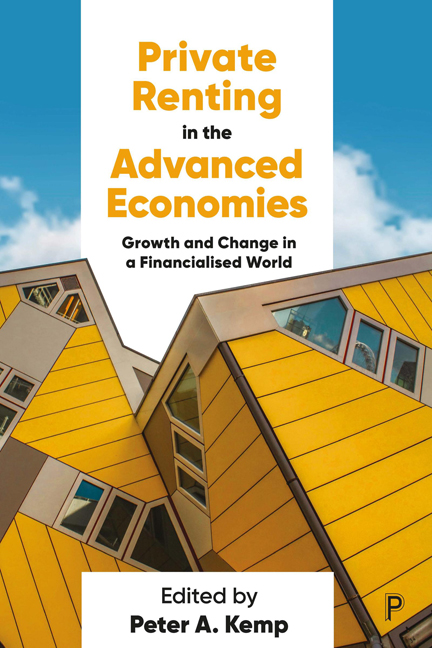Book contents
- Frontmatter
- Contents
- List of figures, tables and boxes
- List of abbreviations
- Notes on contributors
- Preface
- 1 New trajectories in private rental housing
- 2 Growth and change: private renting in Australia in the 21st century
- 3 Rental housing dynamics and their affordability impact in the United States
- 4 The Irish rental sector and the post-homeownership society: issues and challenges
- 5 Private renting in England: growth, change and contestation
- 6 Private renting in the Netherlands: set to grow?
- 7 Suppressive regulation and lower political esteem: private renting in Germany at the beginning of decline
- 8 Private renting in Denmark: foreign investors in the crosshairs
- 9 Norway: booming housing market and increasing small-scale landlordism
- 10 Private rented markets in Spain and housing affordability
- 11 The short-run impact of COVID-19 on the private rented sector
- 12 Change and continuity in private rental housing
- Index
12 - Change and continuity in private rental housing
Published online by Cambridge University Press: 03 April 2024
- Frontmatter
- Contents
- List of figures, tables and boxes
- List of abbreviations
- Notes on contributors
- Preface
- 1 New trajectories in private rental housing
- 2 Growth and change: private renting in Australia in the 21st century
- 3 Rental housing dynamics and their affordability impact in the United States
- 4 The Irish rental sector and the post-homeownership society: issues and challenges
- 5 Private renting in England: growth, change and contestation
- 6 Private renting in the Netherlands: set to grow?
- 7 Suppressive regulation and lower political esteem: private renting in Germany at the beginning of decline
- 8 Private renting in Denmark: foreign investors in the crosshairs
- 9 Norway: booming housing market and increasing small-scale landlordism
- 10 Private rented markets in Spain and housing affordability
- 11 The short-run impact of COVID-19 on the private rented sector
- 12 Change and continuity in private rental housing
- Index
Summary
This book has explored trends in private rental housing in the advanced economies over the past two decades. On the demand side, these trajectories include growth in private renting and more families, couples and higherincome households living in the private rented sector (PRS). On the supply side, developments include the increasing numbers of private individual landlords and the growing importance of various types of large-scale corporate landlords. Internet-based PropTech platforms have become increasingly important in the process of matching tenants and landlords. And the emergence and rapid growth of Airbnb, and other internet-based nightly accommodation hosts, has impacted upon housing supply, prices and rents in popular tourist localities. Taken together, these developments represent a significant, and to some extent, unexpected, change in the nature and role of private rental housing in the first two decades of the 21st century. It is not a wholesale transformation of the sector but rather, to a greater or less extent, a ‘recalibration’ of private renting and its contribution to housing provision in the advanced economies.
The contributions to this book highlight the pivotal impact that the global financial crisis (GFC) has had on recent trajectories of change in private renting. It was the largest economic shock to hit the advanced economies (AEs) since the Great Depression in the interwar years. The subprime mortgage crisis was an important catalyst behind the onset of the GFC and the accompanying fall in house prices in many AEs. It also prompted central banks to introduce macroprudential controls on mortgage lending to households and buy-to-let (BTL) landlords. In the aftermath of the GFC, interest rates declined to historically unprecedented low levels, as central banks cut their policy rates and introduced quantitative easing. One consequence of this new era of cheap money was to decrease bond yields and increase house prices (Mian and Sufi, 2014; Tooze, 2018).
Viewed from an historical institutionalist perspective, the GFC created a ‘critical juncture’ (Pierson, 2004) that helped to shift private renting and owner occupation onto altered trajectories – ‘developmental paths’ – involving variable degrees of re-growth of the former and decline of the latter across many of the AEs.
- Type
- Chapter
- Information
- Private Renting in the Advanced EconomiesGrowth and Change in a Financialised World, pp. 260 - 276Publisher: Bristol University PressPrint publication year: 2023

